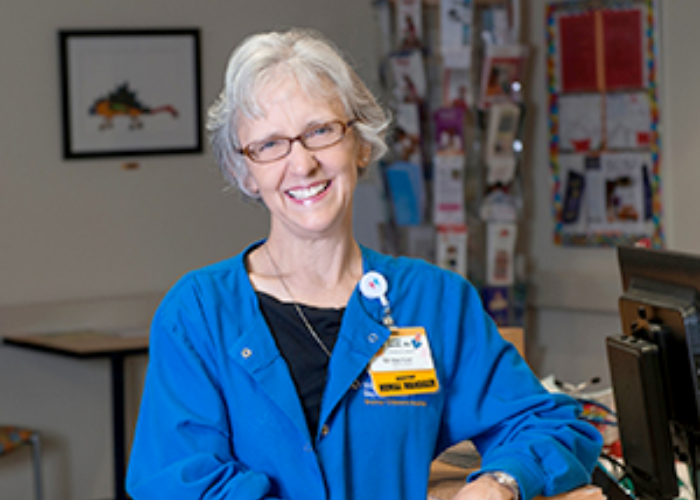
Forty-six years after surgery to remove a spinal tumor, Larry Cox sought out the chemotherapy nurse he remembers being "like a guardian angel."
She turned out to be right where he left her in 1977, still infusing anxious pediatric cancer patients with medicine and hope. And she instantly remembered him.
Nancy Smith, BSN, RN, CPON, assistant nurse manager, Pediatric Hematology Oncology Ambulatory Clinic, Atrium Health Wake Forest Baptist Medical Center, recalled Cox as a “lanky 14-year-old” and herself as a “23-year-old, brand spanking new nurse.” When he started treatment, she discovered she knew his sister, who married one of her husband’s friends.
“He was like my next-door neighbor practically,” Smith, a lifelong resident of King, N.C., said about Cox, who is from nearby Tobaccoville, N.C. “He was the sweetest, kindest patient. I never saw him upset. I can’t remember him ever complaining. He took everything with such bravery.”
“She treated every kid like her own,” Cox recalled. “Chemo was different back then. It was rough. I don’t think I would have made it without the care from her and the other nurses.”
Although Cox faced lasting physical limitations, he went on to graduate high school and worked for several years before retiring on disability. He has lived in Southport, N.C., for the past 17 years.
Early Interest in Pediatric Nursing
Smith joined then-North Carolina Baptist Hospital in May 1975. Fresh out of nursing school and wanting to be a pediatric nurse for as long as she could remember, she took a night shift in the pediatric ward. All pediatric inpatients from babies to teenagers, regardless of condition, were then housed together on a single floor.
Dr. Richard Patterson, the hospital’s only pediatric oncologist, asked her to join his outpatient clinic, and on March 1, 1976, Smith began the role that she still performs today. What accounts for her remarkable 47-year longevity?
“I never wanted to go anywhere else,” Smith explained. “I’ve always loved this patient population and the families. And I had the greatest mentor in Dr. Patterson. He was honest and kind with patients and such a good teacher and role model, basically a father figure to me. I felt blessed to work beside him for so long.”
Dr. Patterson retired from then-Bowman Gray School of Medicine in 1991, as professor of Pediatrics and chief of Pediatric Oncology.
Several childhood events shaped Smith’s early attraction to nursing and pediatric oncology. Her 2 ½ year-old brother died of meningococcemia (a rare infectious disease) when she was a baby. An elementary classmate died with a brain tumor. A friend’s sister died from leukemia. Smith grew up longing to help those suffering.
“I always knew I wanted to be a pediatric nurse,” she said. “Through the years, these accounts of children with cancer tugged my heart in that direction, but I didn’t know I would get the opportunity that Dr. Patterson gave me.”
Advances in Pediatric Oncology
Over the past four decades, Smith witnessed the creation and growth of Brenner Children’s Hospital and numerous advances in pediatric oncology. There is now a unit dedicated to pediatric hematology, and all its nurses are certified in administering chemotherapy. Pediatric specialists work with multidisciplinary teams that include psychologists, social workers, nutritionists and other specialties.
“Cure rates are so much higher today,” Smith said. “We use a lot of the same medicines now, but we have many new ones and use them in a different fashion. We’re much more aggressive today. Kids can tolerate chemotherapy better than most adults can. Their young bodies have not been exposed to as many toxins and bounce back quicker.”
Better medicines for nausea, the advent of central lines and port-a-cath implants for chemotherapy, and numbing creams have also made treatments less stressful for young patients and their nurses.
“I think supportive care overall is better,” Smith said. “Chemotherapy is not an easy road no matter what, but compared to the 1960s and 1970s, we have a lot of new techniques we can offer families now that make the journey through cancer treatment less awful. In the early years, we didn’t have all the cooperative groups that share information. Today, physicians go to meetings and share best practices. That’s one reason we’re curing so many patients today.”
Caring for pediatric cancer patients can be emotionally difficult, and Smith credits her teammates for their mutual support.
“We all want the same thing for these patients and work together to provide excellent care,” she said. “We celebrate victories with them, and we shed tears with them. If we can help these patients and their families get through these tough times and make their paths smoother or better in some way, we’re doing our jobs. Of course, our hope is to cure these children and see them grow to be adults—to be invited to their weddings and to hear about their babies.”
Of all the pediatric cancer survivors who have checked back in with Smith over the years, Cox goes back the farthest. His case is a vivid reminder of the lifelong reach of excellent care. And the kind of outcome that reminds oncology nurses why they dreamed of becoming one.
“It’s been a great career,” Smith said. “I can’t figure out how to stop.”
